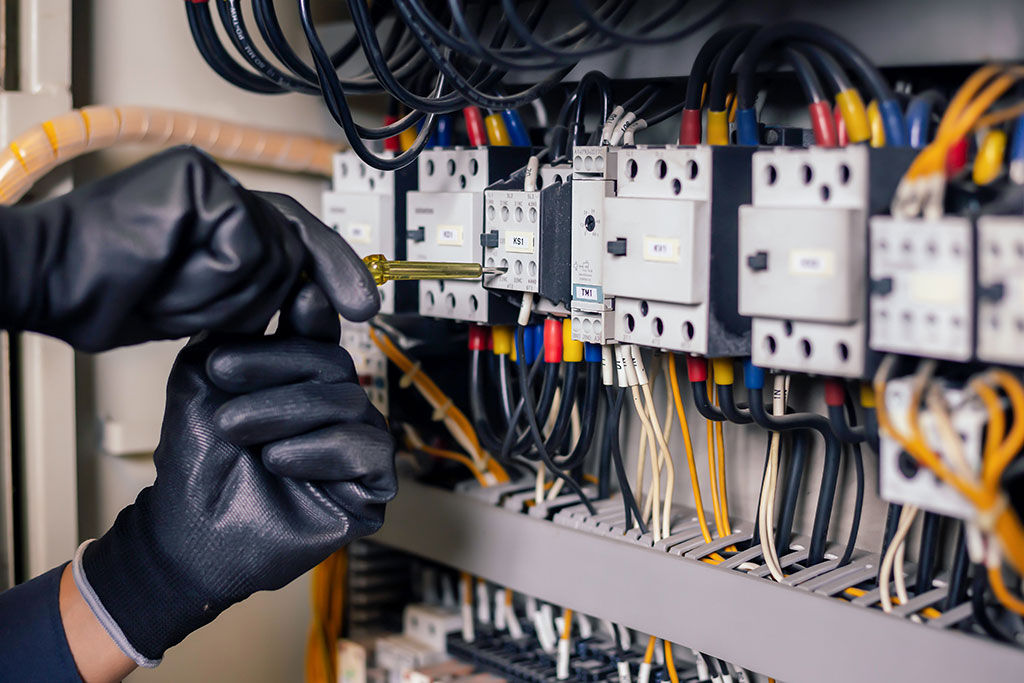Knowing about electrical safety is critically important for you at both work and home.
The following information will help you and your family prevent an electrical incident and your safety & health.
There are four main types of electrical injuries:
- Electrocution (fatal)
- Electric shock
- Burns
- Falls caused as a result of contact with electrical energy

Working Safely with Electricity
Working around live electricity is a serious hazard. Engineers, linemen, electricians, and others who work with electricity directly, and workers who work with electricity indirectly may be exposed to serious electrical hazards.
Equipment
Due to the dynamic, rugged nature of construction work, normal use of electrical equipment causes wear and tear that results in insulation breaks, short-circuits, and exposed wires. If there is no ground-fault protection, it can cause a ground-fault that sends current through a worker’s body. Use ground-fault circuit interrupters (GFCIs) on all 120-volt, single-phase, 15- and 20-ampere receptacles that are not on an existing building’s permanent wiring, or have an assured equipment grounding conductor program (AEGCP). Use double-insulated tools and equipment, distinctively marked. Visually inspect all electrical equipment before use. Remove from service any equipment with frayed cords, missing ground prongs, cracked tool casings, etc.
Power Lines
Overhead and buried power lines are especially hazardous because they carry dangerously high voltage. Fatal electrocution is the main risk but burns and falls are also hazards.
- Look for overhead power lines and buried power line indicators.
- Stay at least 10 feet away from overhead power lines and assume they are energized.
- De-energize and ground lines when working near them.
- Use non-conductive wood or fiberglass ladders when working near power lines.
Extension Cords
Worn cords can expose the wires within or loosen the connections on the plug end. Extension cords that are not 3-wire type, not designed for hard-usage, or that have been modified are not as durable. These conditions can increase the risk of electric shock.
- Use equipment that is approved by a nationally recognized testing laboratory.
- Do not modify cords or use them incorrectly.
- Use factory-assembled cord sets and extension cords that are 3-wire type.
- Use cords, connection devices, and fittings equipped with strain relief.
- Remove cords from receptacles by pulling on the plugs, not the cords.
Electrical Incidents
If the power supply to the electrical equipment is not grounded or the path has been broken, fault current may travel through a worker’s body, causing electrical burns or death. Visually inspect electrical equipment before use. Take any defective equipment out of service.
- Ground all power supply systems, electrical circuits, and electrical equipment.
- Frequently inspect electrical systems to ensure that the path to ground is continuous.
- Do not remove ground prongs from cord- and plug-connected equipment or extension cords.
- Use double-insulated tools and ground all exposed metal parts of equipment.
- Avoid standing in wet areas when using portable electrical power tools.

Generators
Generators are commonly used as a replacement source of electricity when electrical power is lost. Most generators are gasoline or diesel powered with internal combustion engines which turn an alternator to produce electricity. One of the hazards from gasoline or diesel powered engines is carbon monoxide (CO). Carbon monoxide is a colorless, odorless gas produced during the operation of gasoline powered generators. When inhaled, the gas reduces your ability to transport oxygen. Symptoms of carbon monoxide poisoning include headache, nausea and fatigue that can lead to unconsciousness and ultimately prove fatal. The following information is a list of best practices to identify hazards when operating around power lines and electrical equipment.
- DO NOT operate a generator indoors. Generators should be placed outdoors in a location where the exhaust gases cannot enter a home or building. Good ventilation is key to operating a generator safely.
- Be sure the main circuit breaker is OFF and locked out prior to starting any generator. This will prevent inadvertent energization of power lines from backfeed electrical energy from generators and help protect utility line workers from electrocution.
- Turn off generators and let them cool prior to refueling.
Seven Electrical Safety Tips For Your Home

Using electricity is second nature. We run our air conditioning constantly, use refrigerators, microwaves and indoor lighting, and charge computers, phones and other devices daily. Now, more than ever, it’s easier to mismanage our energy use and appliances at home, which could either overwork our system or even create an electrical accident.
Learning how to properly use your home’s electrical system and your electronic devices can make a huge difference in how efficiently your electricity is working for your home. It can also help prevent electrical accidents and keep you and your family safe.
Stay safe at home with these seven tips:
- Avoid overloading outlets
Make sure your outlet isn’t being overloaded with too many devices and appliances using adapters and extension cords. Additionally, only one heat-producing device should be plugged into an outlet at a time (coffee maker, hair dryer, etc.), and refrigerators, ovens, laundry machines and other major appliances should be plugged straight into the wall and not an adapter or extension cord. - Unplug appliances when not in use
Not only will unplugging appliances prevent you from using unnecessary energy, it could also help protect your appliances from surges and other electrical mishaps. - Use the proper wattage for lamps and lighting fixtures
The recommended wattage is what keeps your lamps shining safely. There should be a sticker indicating the maximum wattage of the bulb needed. Lamps should also be used with a shade or globe to prevent other items heating up if they’re too close to the bulb – particularly if you’re using incandescent bulbs. LEDs are a great way to light up a room without all the wasted heat energy. - Never run cords under carpets, rugs, doors or windows
Running cords throughout your house can cause tripping hazards as well as inviting electrical accidents when they’re consistently out in the open. And a cord under a rug or carpet is a fire hazard. If you find you’re using extension cords regularly, consult your electrician about adding new outlets around your home within reach of the things you need to plug in. - Get rid of damaged extension cords
Making sure you’re using the correct extension cord for the environment and circumstance will help prolong the lifespan of your cords, but they’re meant to be replaced as needed. Instead of trying to fix damaged cords, updating or upgrading your extension cords when they’re not working properly will help prevent sparks, surges and electrical fires. Your extension cords should also have surge protectors. - Keep electrical appliances and tools away from water
You’re probably well aware that water and electricity don’t mix, but it’s sometimes easy to overlook hazards in everyday situations. Make sure you’re keeping kitchen appliances a safe distance from sinks and other appliances that use water. Also, be sure that all outlets near a water source are ground fault circuit interrupters, or GFCI, receptacles. These can quickly shut off power at the outlet when a short circuit is detected. - Call a professional
If your lights are flickering, your circuits are tripped frequently, you see sparks or smell burning or rubbery odors, it’s time to call a trained electrician. These warnings signal a larger electrical problem that needs to be addressed at the source quickly rather than waiting it out or leaning on a temporary solution.
Many of us are working or spending more time at home in general. Following these basic electrical safety tips can help you avoid serious electrical issues or injuries. They’ll also help you save energy and money on your utility bill, too.
Electrical Safety Checklist:
- Work on new and existing energized (hot) electrical circuits is prohibited until all power is shut off and grounds are attached.
- An effective Lockout/Tagout system is in place.
- Frayed, damaged or worn electrical cords or cables are promptly replaced.
- All extension cords have grounding prongs.
- Protect flexible cords and cables from damage. Sharp corners and projections should be avoided.
- Use extension cord sets used with portable electric tools and appliances that are the three-wire type and designed for hard or extra-hard service. (Look for some of the following letters imprinted on the casing: S, ST, SO, STO.)
- All electrical tools and equipment are maintained in safe condition and checked regularly for defects and taken out of service if a defect is found.
- Do not bypass any protective system or device designed to protect employees from contact with electrical energy.
- Overhead electrical power lines are located and identified.
- Ensure that ladders, scaffolds, equipment or materials never come within 10 feet of electrical power lines.
- All electrical tools must be properly grounded unless they are of the double insulated type.
- Multiple plug adapters are prohibited.

For more information visit these links:
Electrical Safety Foundation International
www.esfi.org
Electrical Injury & Fatality Statistics
https://esfi.org/workplace-safety/workplace-injury-fatality-statistics/
Occupational Safety & Health Administration – Electrical
https://www.osha.gov/electrical/construction
OSHA – Construction Electrical Incidents
https://www.osha.gov/etools/construction/electrical-incidents
CDC Electrical Safety
https://www.cdc.gov/niosh/topics/electrical/


